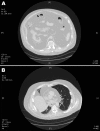Adenovirus 36 DNA in adipose tissue of patient with unusual visceral obesity
- PMID: 20409382
- PMCID: PMC2953992
- DOI: 10.3201/eid1605.091271
Adenovirus 36 DNA in adipose tissue of patient with unusual visceral obesity
Abstract
Massive adipose tissue depositions in the abdomen and thorax sufficient to interfere with respiration developed in a patient with multiple medical problems. Biopsy of adipose tissue identified human adenovirus 36 (Adv 36) DNA. Adv 36 causes adipogenesis in animals and humans. Development of massive lipomatosis may be caused by Adv 36.
Figures


Similar articles
-
Adenovirus 36 DNA in human adipose tissue.Int J Obes (Lond). 2015 Dec;39(12):1761-4. doi: 10.1038/ijo.2015.163. Epub 2015 Aug 21. Int J Obes (Lond). 2015. PMID: 26293231
-
A case of urethritis caused by human adenovirus type 56.Jpn J Infect Dis. 2012;65(3):273-4. doi: 10.7883/yoken.65.273. Jpn J Infect Dis. 2012. PMID: 22627315 No abstract available.
-
PCR method for detection of adenovirus in urine of healthy and human immunodeficiency virus-infected individuals.J Clin Microbiol. 1998 Nov;36(11):3323-6. doi: 10.1128/JCM.36.11.3323-3326.1998. J Clin Microbiol. 1998. PMID: 9774586 Free PMC article.
-
Adenovirus-36 as one of the causes of obesity: the review of the pathophysiology.Nutr Res. 2021 Feb;86:60-67. doi: 10.1016/j.nutres.2020.12.004. Epub 2020 Dec 4. Nutr Res. 2021. PMID: 33551256 Review.
-
Infeccions as the etiology for obesity.Arq Bras Endocrinol Metabol. 2009 Mar;53(2):159-64. doi: 10.1590/s0004-27302009000200007. Arq Bras Endocrinol Metabol. 2009. PMID: 19466208 Review.
Cited by
-
HIV Persistence in Adipose Tissue Reservoirs.Curr HIV/AIDS Rep. 2018 Feb;15(1):60-71. doi: 10.1007/s11904-018-0378-z. Curr HIV/AIDS Rep. 2018. PMID: 29423731 Free PMC article. Review.
-
Presence of Adenovirus-36 DNA in Adipose Tissue of Women: Relationship with Adipocyte Morphology and the Expression of C/EBPβ and HIF-1α.Diabetes Metab Syndr Obes. 2021 Feb 3;14:477-486. doi: 10.2147/DMSO.S285341. eCollection 2021. Diabetes Metab Syndr Obes. 2021. PMID: 33568924 Free PMC article.
-
Beyond energy balance regulation: The underestimated role of adipose tissues in host defense against pathogens.Front Immunol. 2023 Mar 2;14:1083191. doi: 10.3389/fimmu.2023.1083191. eCollection 2023. Front Immunol. 2023. PMID: 36936928 Free PMC article. Review.
-
ADV36 adipogenic adenovirus in human liver disease.World J Gastroenterol. 2014 Oct 28;20(40):14706-16. doi: 10.3748/wjg.v20.i40.14706. World J Gastroenterol. 2014. PMID: 25356033 Free PMC article. Review.
-
Extended receptor repertoire of an adenovirus associated with human obesity.PLoS Pathog. 2025 Jan 30;21(1):e1012892. doi: 10.1371/journal.ppat.1012892. eCollection 2025 Jan. PLoS Pathog. 2025. PMID: 39883726 Free PMC article.
References
-
- Dhurandhar NV, Whigham LD, Abbott DH, Schultz-Darken NJ, Israel BA, Bradley SM, et al. Human adenovirus Ad-36 promotes weight gain in male rhesus and marmoset monkeys. J Nutr. 2002;132:3155–60. - PubMed
Publication types
MeSH terms
Substances
LinkOut - more resources
Full Text Sources
Medical
